Club Night Report
Wednesday 15th October 2014
Club Night Report for 15th October 2014 - observations by Vernon HughesWe knew that there would be no visiting demonstrator and that Club Members were to carry the proceedings. Most of us had little or no idea of what lay in store though, so what a pleasant surprise to discover as the evening wore on that eight Members would rise nobly to the challenge for varying lengths of time.
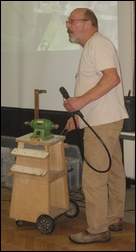 |
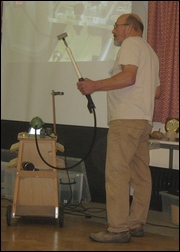 |
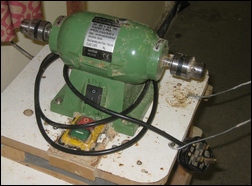 |
 |
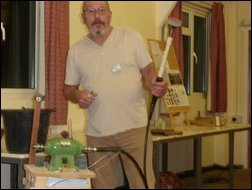 |
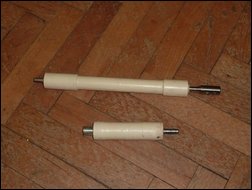 |
The first presenter was Bob Sawyer showing his ingenious 'Sanding Station'. Its shape was a sawn-off obelisk with a flat top, various side-fitments plus wheels for easy movement round the workshop. On the flat top was mounted a smart-looking 'Kirjes Sanding and Polishing System' sourced from 'Classic Hand Tools' (www.classichandtools.com). Other suppliers in the UK include Stiles and Bates and Turners Retreat/ Craft Supplies - prices range from £270 - £290 (do your own research).
The main system component consists of a drive motor with a Jacobs style chuck at each end, along with a heavy duty flexible drive shaft and inflatable bobbins. The motor running speed is 3000 rpm - unusually high for sanding but he makes it work. A major benefit of using this system is that apart from being robust and long lasting it is quiet! The device can be used for static sanding using every shape, form and design of spindled attachment imaginable and for power sanding using the sturdy flexible drive shaft. It also serves as an excellent buffing machine, again using a wide range of dome mops and '50-sheet' wheels, etc. These can be cleaned readily by applying a hand-held wire brush firmly against them as they spin.
The 'Kirjes' 4-page pamphlet displays a wide range of the attachments that it markets, including pneumatic rubber shapes, Velcro-fitted forms, long-reach spindles, etc. etc., and there is scope of course to devise your own. Bob has made a 'special' to get behind the shoulders of pieces made with this feature. A final quote from Bob - "I wouldn't be without it!"
All-in-all this demo was an eye-opener that is bound to get the imagination working even if investment in the machine is not within your personal budgetary powers of approval. To learn more, simply Google 'Kirjes' and the full works will be opened up for you.
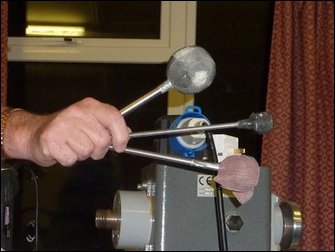 |
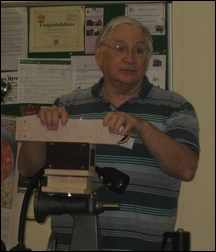 |
Next came our Chairman Mike Crawshaw introducing the concept of home-made long-reach sanding spheres/ balls and a lathe steady for stabilising faceplate work.
The spheres were mounted on mild steel bar and were made from adhesive polyurethane foam sourced in sheets from eBay - plus the application of duct tape and Velcro to hold the abrasive. David Reed-Smith's (davidreedsmith.com/Articles/FoamBallSander/FoamBallSander.htm ) website is a useful source of information about the construction of the ball-sanders (there is an 11 page PDF download available on the site); and the types and application methods for the various types of abrasive (including 'Abranet') are open to individual imagination and need. The resulting ball is then used in a cordless drill. Mike will prepare his own article on the subject for publication later.
He then turned to the lathe platter steady. This was unusual because its purpose is to support faceplate (not spindle) work at the back of the dish, platter, etc. being turned in order to overcome harmonics (high vibration) experienced, particularly with thinner pieces especially near the rim. His base design was for fixing on his - twin bed-bar, swivelling/ sliding headstock, Record CL4 lathe, but was of course capable of variation to suit any type of lathe bed. The Record lathe headstock can be swivelled 90 degrees to enable larger diameter pieces to be turned. By swivelling the headstock and then sliding it down the bed bars (towards the tailstock) - the 'platter steady' can be mounted to the left of the headstock. The contact point with the turned work is a rollerblade inline skate wheel - approx. 75 mm in diameter. These come in varying degrees of hardness of which Mike used the softest (cost approx. £4 each via eBay). He has experienced no more than the very slightest marking by the wheel on the timber (at the contact point) and has removed any marking very easily. He has successfully turner many thin wall platters using this steady. Design plans will be made available later.
He added that a template 3-point steady for use in spindle work had been made and the details will be published soon. This is one of the projects to emerge from the Club's Jigs and Tools Special Interest Group. A further project currently being investigated is the design/ manufacture of a toolpost-mounted drilling jig - for horizontal drilling on the centreline of the work and then indexed (in the headstock) to generate patterns/ holes for decorative plugs.
Mike also mentioned his cordless drill battery pack project - full plans are available on the Club website here: www.northwiltswoodturners.co.uk/OddsEnds#techniques - then scroll down to "Jigs and Tooling Special Interest Group". The J&T group generally meets on the Thursday prior to the Club's Wednesday meeting between 7.00 and 9.00 pm - contact Mike for further details.
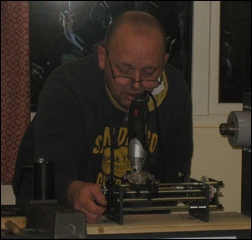 |
 |
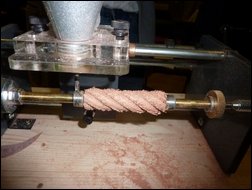 |
 |
Iain Bell demonstrated the use of the American 'Beall Pen Wizard' (an Ornamental Pen Lathe) which can also be used for other small spindle-shaped items such as keyrings and needle cases. Photographs are included of the machine and some examples of the finished product. It will be seen that immense variety is achievable. Full particulars can be obtained by visiting the website (there is also a video...): www.bealltool.com/products/penwizard/penwiz.php.
The sole UK supplier was The Toolpost in Didcot - before they ceased trading. Note: it is an expensive piece of kit att around £300! (PLUS the addition of a Dremel type tool to drive the cutter).
Starting with a 1 1/4" diameter blank, Iain demonstrated perfectly the cutting of a pen body having six spiral grooves, spacing being judged by eye to save time. It is possible to achieve 48 indexing positions. The machine has a reverse function. A single (carbide) bit can cost £35 but a set of seven is available for £85. Iain commented that he "loved his pens" - and still had a lot to learn about the capabilities of his mini ornamental lathe. A couple of the benefits of the machine are that it is of table top size and can be operated whilst sitting down. Iain said you would still need a regular wood turning lathe for the efficient preparation of the blanks. In the right hands the 'Pen Wizard' can certainly take pen making to undreamed of heights.
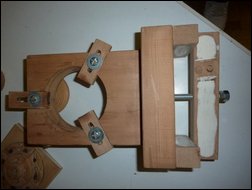 |
Harry Rock pitched in with an invaluable, 'cheap and cheerful' - self-made, three-point steady for use in long spindle turning. Its design is intended, like Mike's, for mounting on a 'twin bedbar' lathe but the design of that component can be varied according to need. The design does not make use of wheels or bearings at the contact points - so there is wood to wood contact, which Harry eases with a touch of candle wax. Again, any marking challenges can be easily overcome. Harry went on to show and explain his very efficient and safe light-pull drilling/ driver kit.
 |
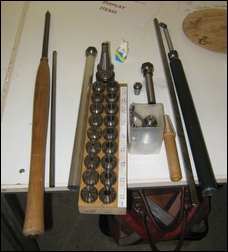 |
Arthur Kingdon introduced his self-designed and made turning tools utilising aluminium grade carbide tips mounted on 2 ft long, square and round steel bars. The tips are available in sizes ranging from 6 - 12 mm diameter (cost approx. £5 each) plus a 'torx' screw to secure the tip to the bar - which requires minimal machining and shaping. The square bar holds the tip at 45 degrees for a very safe and productive shear scraper used for hollowing. The tip mounted on a round bar would allow for more aggressive cuts!
He also described self-made tool handle options using engineering ER20 collets, in a standard parallel shank industrial tool holder. The collets are available from 1 mm to 13 mm diameter in 1 mm increments. Arthur used thick-walled aluminium tubing, covered with polyurethane foam and heat-shrink tubing for the construction of the handle. Total cost to produce his handle was about £30 compared with the equivalent commercial version at. £70 plus.
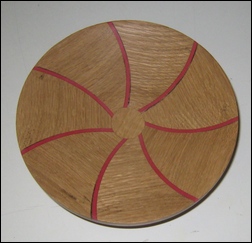 |
 |
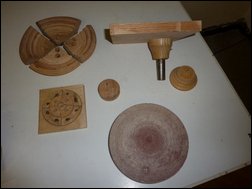 |
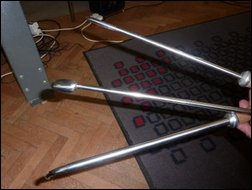 |
Well there we are. We had been provided with a most interesting, but more importantly highly informative, series of demonstrations and talks. What depths of knowledge, expertise, enthusiasm and enterprise are possessed by our Membership! Thank you.
<Top of Page>
The Show and Tell theme for this month was: An Item in Different Woods - this was reasonably well supported and displayed a number of interesting items...
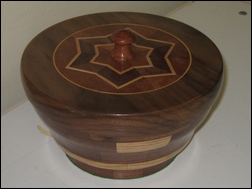 |
 |
 |
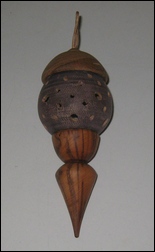 |
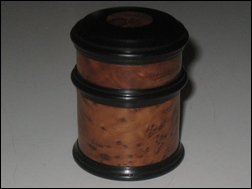 |
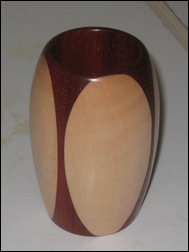 |
It was announced that for the first time there was a tie for the Show and Tell winner between three items.
Arthur Kingdon had entered a small box made in Moroccan Thuya Burr and African Blackwood
Harry Rock entered a vase made in Padauk and Sycamore
Ken Gately's inventive Candle Holder had a base made from Indian Rosewood with a Hickory candle and a Pink Ivory 'flame'. Considering that this was Ken's first attempt at the Show and Tell - he was declared the winner and was presented the Show and Tell shield by Club Chairman Mike Crawshaw.
 |
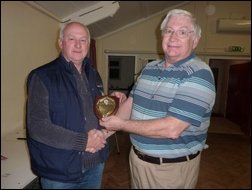 |
<Top of Page>
